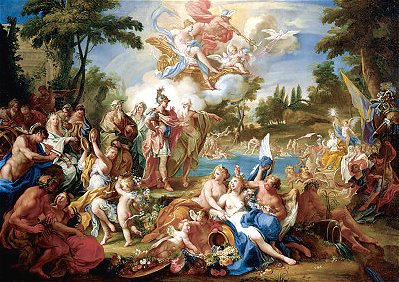 |
|
THE VISION OF AENEAS IN THE ELYSIAN FIELDS
Sebastiano Conca Italian 1680-1764
SN 168 Oil on Canvas 1735-40
by Robert Anderson
ARTIST
This Italian painter was one of the most important decorative painters
in Rome during the first half of the 18th century. Out of the High Baroque tradition he
developed a distinctly Roman Rococo style which thru its polished elegance gives the
impression of superficiality despite the grandeur of its conception. Conca painted
altarpieces and frescos, creating an accomplished style and his smaller easel pieces were
eagerly sought after by collectors throughout Europe. He was also an able draughtsman,
working in a free and fluent style. |
While in Rome in his 20's he was inspired by the works
of Michelangelo and the Carracci and developed a greater classicism in his work. The
1730's marked the climax of a long and successful career.His output was prodigious and his
altarpieces were sent to cities all over Italy. His mythological easel paintings in
particular(e.g. Aeneas Desending to the Underworld) were sought after by private
collectors. These are lyrical Rococo works, distinguished by their spontaneous brushwork
and liquid colors.
SUBJECT
The subject of the painting is from the Roman poet Virgil. His Aeneid
tells the story of Aeneas, a Trojan hero and son of Venus, meeting his father, Anchises,
in the underworld Elysian Fields. There he is told of his future destiny as the founder of
Rome and about its dynasty of leaders.
Elysium was, as Virgil described it, a part of Hades, but also a
residence for the spirits of the blessed ( heros, statesmen etc.). Aeneas saw the founders
of the Trojan state who had lived in happier times as well as those spirits whose
destinies and worthy deeds were to be achieved in coming times.
Elysium was perceived as a beautiful valley with trees gently waving, a
tranquil landscape thru which the river Lethe flowed. Along the bank of the stream
wandered a multitude who were the souls which were to be given bodies in due time after
the impurities and memories of their past lives were washed away.
Aeneas was told of the events that remained to him to be accomplished
before the complete establishment of himself and his followers in Italy. Wars were to be
waged, a bride to be won, and a Trojan state founded from which would rise the Roman
power, to be in time the sovereign of the world.
PAINTING
Aeneas is led by his father, Anchises, and followed by the Sibyl and
the Seer Musaeus, gazes at the groves where the blissful reside. The goddess Roma in a
chariot drawn by lions approaches him while a genius of light holds a flaming torch over
her head. Among her followers can be recognized Numa Pompilius, the lawgiver, with
Augustus and Marcellus on horseback: a prophecy of the future grandeur of Rome. Floating
above Aeneas is his mother Venus with Cupid and Mercury, in a chariot drawn by doves with
a red ribbon. At the left is the poet Virgil with a lyre, surrounded by philosophers and
astrologers, shepherds and maidens who sing his bucholic poems.
HISTORICAL CONTEXT
Virgil born in 70 B.C. was active during the time of Octavian's rule
over Rome. He was spnsored by a politician / statesman named Maecenas who introduced him
and his poetry to Octavian. His first major efforts were poems glorifying rural life which
coincided with the aims of Octavian who wanted to settle his former soldiers on farm land.
Later he wrote the epic poem, The Aeneid, which came to include by preview through
prophecy, the expansion of Rome into the Augustan empire and peace. Virgil flatters his
Emperor and his country in an epic that was never finished but which was enthusiastically
accepted by Augustus. Its real religion is patriotism and its greatest god is Rome. |
